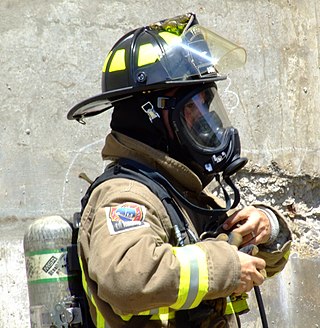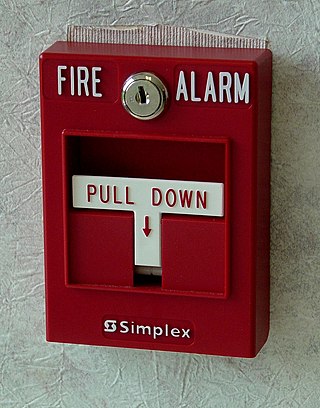
An emergency position-indicating radiobeacon (EPIRB) is a type of emergency locator beacon for commercial and recreational boats, a portable, battery-powered radio transmitter used in emergencies to locate boaters in distress and in need of immediate rescue. In the event of an emergency, such as a ship sinking or medical emergency onboard, the transmitter is activated and begins transmitting a continuous 406 MHz distress radio signal, which is used by search-and-rescue teams to quickly locate the emergency and render aid. The signal is detected by satellites operated by an international consortium of rescue services, COSPAS-SARSAT, which can detect emergency beacons anywhere on Earth transmitting on the distress frequency of 406 MHz. The satellites calculate the position or utilize the GPS coordinates of the beacon and quickly passes the information to the appropriate local first responder organization, which performs the search and rescue. As Search and Rescue approach the search areas, they use Direction Finding (DF) equipment to locate the beacon using the 121.5 MHz homing signal, or in newer EPIRBs, the AIS location signal. The basic purpose of this system is to help rescuers find survivors within the so-called "golden day" during which the majority of survivors can usually be saved. The feature distinguishing a modern EPIRB, often called GPIRB, from other types of emergency beacon is that it contains a GPS receiver and broadcasts its position, usually accurate within 100 m (330 ft), to facilitate location. Previous emergency beacons without a GPS can only be localized to within 2 km (1.2 mi) by the COSPAS satellites and relied heavily upon the 121.5 MHz homing signal to pin-point the beacons location as they arrived on scene.

A firefighter is a first responder trained in firefighting, primarily to control and extinguish fires that threaten life and property, as well as to rescue persons from confinement or dangerous situations. Male firefighters are sometimes referred to as firemen.

A self-contained breathing apparatus (SCBA) is a device worn to provide an autonomous supply of breathable gas in an atmosphere that is immediately dangerous to life or health. They are typically used in firefighting and industry. The term self-contained means that the SCBA is not dependent on a remote supply of breathing gas. If designed for use under water, it is also known as a scuba set. When not used underwater, they are sometimes called industrial breathing sets. Some types are also referred to as a compressed air breathing apparatus (CABA) or simply breathing apparatus (BA). Unofficial names include air pack, air tank, oxygen cylinder or simply pack, which are mostly used in firefighting.
A distress signal, also known as a distress call, is an internationally recognized means for obtaining help. Distress signals are communicated by transmitting radio signals, displaying a visually observable item or illumination, or making a sound audible from a distance.

A smoke detector is a device that senses smoke, typically as an indicator of fire. Smoke detectors are usually housed in plastic enclosures, typically shaped like a disk about 150 millimetres (6 in) in diameter and 25 millimetres (1 in) thick, but shape and size vary. Smoke can be detected either optically (photoelectric) or by physical process (ionization). Detectors may use one or both sensing methods. Sensitive alarms can be used to detect and deter smoking in banned areas. Smoke detectors in large commercial and industrial buildings are usually connected to a central fire alarm system.
In firefighting, the policy of two-in, two-out refers to United States Occupational Safety and Health Administration (OSHA) policy 29 CFR 1910.134(g)(4)(i). The respiratory protection standard requires that workers engaged in fighting interior structural fires work in a buddy system; at least two workers must enter the building together, so that they can monitor each other's whereabouts as well as the work environment. There must also be at least two standby personnel outside the fire area prepared to rescue the inside firefighters should the need arise. One of these outside firefighters must actively monitor the status of the inside fighters but the second outside firefighter may perform a variety of other duties, such as pump operations, incident commander or outside hose line operation. There are no provisions in the standard to waive the requirements for either the "two-inside firefighters" or the "two-outside firefighters", although the circumstances under which this provision applies are more limited than generally understood.
Firefighting jargon includes a diverse lexicon of both common and idiosyncratic terms. One problem that exists in trying to create a list such as this is that much of the terminology used by a particular department is specifically defined in their particular standing operating procedures, such that two departments may have completely different terms for the same thing. For example, depending on whom one asks, a safety team may be referred to as a standby, a RIT or RIG or RIC, or a FAST. Furthermore, a department may change a definition within its SOP, such that one year it may be RIT, and the next RIG or RIC.
This is a glossary of firefighting equipment.

A hazmat suit is a piece of personal protective equipment that consists of an impermeable whole-body garment worn as protection against hazardous materials.
A firefighter assist and search team (FAST), also known as a rapid intervention team/rapid intervention crew/rapid intervention dispatch (RIT/RIC/RID), is a team of two or more firefighters dedicated solely to the search and rescue of other firefighters in distress. Firefighter Assist and Search Team personnel shall have no other operational assignment during any incident. Multiple alarm fires may require multiple FAST/RIC teams.

Manual fire alarm activation is the process of triggering a fire alarm through a call point, pull station, or other device. This usually causes the alarm to sound the evacuation signal for the relevant building or zone. Manual fire alarm activation requires human intervention, as distinct from automatic fire alarm activation such as that provided through the use of heat detectors and smoke detectors. It is, however, possible for call points/pull stations to be used in conjunction with automatic detection as part of the overall fire detection and alarm system. Systems in completed buildings tend to be wired in and include a control panel. Wireless activators are common during construction.

A panic alarm is an electronic device that can easily be activated to request help during an emergency where danger to persons or property exists. It is designed to contact assistance quicker, easier, and simpler than a conventional phone call.
Fire prevention is a function of many fire departments. The goal of fire prevention is to educate the public on the precautions which should be taken to prevent potentially harmful fires and how to survive these fires if they do occur. It is a proactive method of preventing fire-based emergencies and reducing the damage caused by them. Many fire departments have one or more Fire Prevention Officers, which may also be a routine duty of firefighters.
Active fire protection (AFP) is an integral part of fire protection. AFP is characterized by items and/or systems, which require a certain amount of motion and response in order to work, contrary to passive fire protection.

A fire alarm system is a building system designed to detect and alert occupants and emergency forces of the presence of smoke, fire, carbon monoxide, or other fire-related emergencies. Fire alarm systems are required in most commercial buildings. They may include smoke detectors, heat detectors, and manual fire alarm activation devices, all of which are connected to a Fire Alarm Control Panel (FACP) normally found in an electrical room or panel room. Fire alarm systems generally use visual and audio signalization to warn the occupants of the building. Some fire alarm systems may also disable elevators, which under most circumstances, are unsafe to use during a fire.

Bunker gear is the personal protective equipment (PPE) used by firefighters. The term is derived from the fact that the trousers and boots are traditionally kept by the firefighters bunk at the fire station to be readily available for use.

Firefighter rehabilitation is a vital firefighting service, providing firefighters and other emergency personnel with immediate medical attention including rehydration, treatment for smoke inhalation, and the prevention of life-threatening conditions such as heatstroke and heart attack after working at the scene of an incident. Firefighter rehabilitation can include a variety of things from a simple check up to deciding whether or not the firefighter needs to see a doctor. The rehabilitation area is set up in a safe location near the incident so that it can be accessible to any emergency responders who may need it.

New York City Fire Department Rescue Company 1, also known as Rescue 1, is one of five special operations rescue companies of the New York City Fire Department (FDNY) that responds to rescue operations that require specialized equipment and training. It was organized on March 8, 1915.

An air and light unit, also known as a breathing support unit, is a specialized piece of firefighting apparatus used by firefighters to provide supplemental lighting and SCBA air bottles at the scene of an emergency. During prolonged emergencies, particularly structure fires, where firefighters must remain on air, these air bottles will need to be replaced and refilled. The air and light unit has the ability to refill the SCBA bottles while in the field using onboard air compressors (cascade). It also carries a supply of spare air cylinders. These units are highly customizable and can vary greatly between departments. These multifunctional units are also equipped with diesel generators which supply electricity to power portable lights and overall scene illumination equipment. This is usually done via a roof-mounted telescoping light bank. The unit also has the ability to supply electrical power in an emergency to a shelter, base camp, or medical facility.

ISO 7010 is an International Organization for Standardization technical standard for graphical hazard symbols on hazard and safety signs, including those indicating emergency exits. It uses colours and principles set out in ISO 3864 for these symbols, and is intended to provide "safety information that relies as little as possible on the use of words to achieve understanding."













